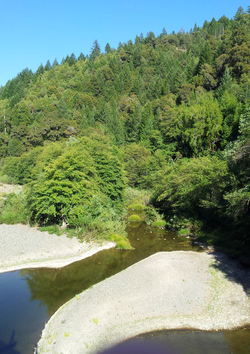| Outlet Creek | |
|---|---|
 Outlet Creek at Longvale, California | |
| Location | |
| Country | United States |
| State | California |
| Region | Mendocino County |
| Physical characteristics | |
| Source | |
| • location | Willits, California |
| • coordinates | 39°27′03″N 123°20′54″W / 39.45083°N 123.34833°W[1] |
| • elevation | 1,342 ft (409 m) |
| Mouth | Eel River |
• coordinates | 39°37′37″N 123°20′43″W / 39.62694°N 123.34528°W[2] |
• elevation | 1,014 ft (309 m) |
| Length | 17 mi (27 km) |
Outlet Creek is an Eel River tributary draining the Little Lake Valley northerly through a canyon of the California Coast Ranges.[3] The Northwestern Pacific Railroad bridges the creek twelve times, following it through the canyon.[4] California State Route 162 bridges the creek once, following the canyon closely downstream of Longvale, California, and U.S. Route 101 bridges the creek twice, paralleling it less closely upstream of Longvale. After leaving Quaternary alluvium of the Little Lake Valley, the canyon exposes undivided Cretaceous marine sedimentary and metasedimentary rocks upstream of Longvale and Franciscan Assemblage downstream of Longvale.[5] Outlet Creek provides groundwater recharge, recreation, and agricultural and industrial water supply plus wildlife habitat including cold freshwater habitat for fish migration and spawning.[6]
References
[edit]- ^ U.S. Geological Survey Geographic Names Information System: Willits Division
- ^ U.S. Geological Survey Geographic Names Information System: Outlet Creek
- ^ DeLorme California Atlas and Gazetteer (1st edition) (2008) ISBN 0-89933-383-4 map 47
- ^ Gale, V.J. and Valles, R.C.(Roadmasters) (1978). (untitled maintenance-of-way charts). Southern Pacific Railroad.
{{cite book}}: CS1 maint: multiple names: authors list (link) - ^ Jennings, Charles W. & Strand, Rudolph G. Geologic Map of California:Ukiah Sheet (1960) State of California Resources Agency
- ^ State of California Water Quality Control Plan North Coastal Basin 1B July 1975 p. 13
See also
[edit]
Well, that’s interesting to know that Psilotum nudum are known as whisk ferns. Psilotum nudum is the commoner species of the two. While the P. flaccidum is a rare species and is found in the tropical islands. Both the species are usually epiphytic in habit and grow upon tree ferns. These species may also be terrestrial and grow in humus or in the crevices of the rocks.
View the detailed Guide of Psilotum nudum: Detailed Study Of Psilotum Nudum (Whisk Fern), Classification, Anatomy, Reproduction